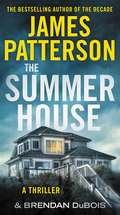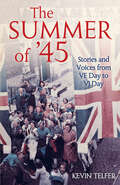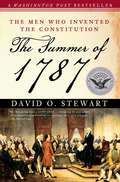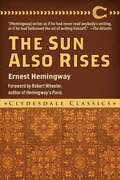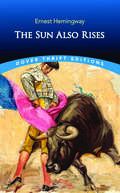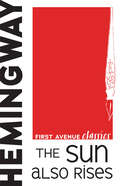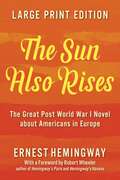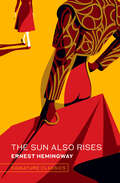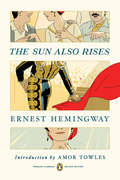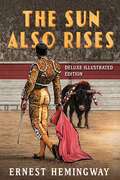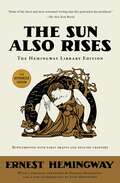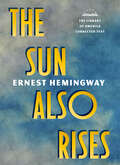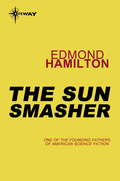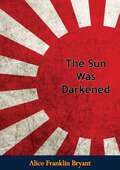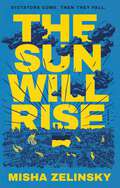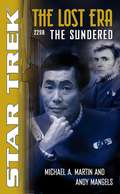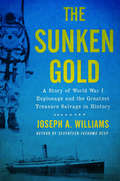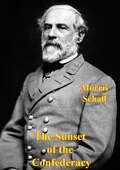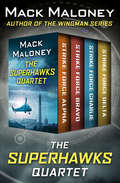- Table View
- List View
The Summer Day is Done: a magical and captivating romantic wartime saga that will keep you gripped
by Mary Jane StaplesIf you like Katie Flynn, Kristin Hannah and Fiona Valpy, you will love this enthralling, heart-wrenching page-turner of a romantic adventure from multi-million copy seller Mary Jane Staples.READERS ARE LOVING THE SUMMER DAY IS DONE!"I couldn't put it down" - 5 STARS"A good and entertaining read" - 5 STARS"Perfect" - 5 STARS***********************************************************************************WILL WAR DEAL THE CRUELLEST BLOW OF ALL?Russia 1911: Young British agent John Kirby comes to Russia to work and to explore a new and exciting country - not to fall in love. But an invitation to the Tsar's ball changes all that. After an evening of dancing and romance, John and the Tsar's eldest daughter, Olga, are totally captivated by one another.Summers of tennis parties and picnics with Olga follow - life could not get any better. Until a cruel blow is dealt in 1914: John is forced to return to England and Olga and her family are caught up in the bitter and bloody war.Will John and Olga ever be reunited? Can their love survive the odds? Or will tragedy, pain and longing destroy them both?The Summer Day is Done was previously published as Woman in Berlin.
The Summer House: The Classic Blockbuster from the Author of Lion & Lamb
by James Patterson Brendan DuBoisWhen seven murder victims are found in a small town, the homicide investigation shakes a small-town sheriff to her core in James Patterson's tense thriller.Once a luxurious southern getaway on a rustic lake, then reduced to a dilapidated crash pad, the Summer House is now the grisly scene of a nighttime mass murder. Eyewitnesses point to four Army Rangers—known as the Night Ninjas—recently returned from Afghanistan.To ensure that justice is done, the Army sends Major Jeremiah Cook, a veteran and former NYPD cop, to investigate. But the major and his elite team arrive in sweltering Georgia with no idea their grim jobs will be made exponentially more challenging by local law enforcement, who resists the Army's intrusion and stonewall them at every turn. As Cook and his squad struggle to uncover the truth behind the condemning evidence, the pieces just won't fit—and forces are rallying to make certain damning secrets die alongside the victims in the murder house. With his own people in the cross-hairs, Cook takes a desperate gamble to find answers—even if it means returning to a hell of his own worst nightmares . . .
The Summer of '45: Stories and Voices from VE Day to VJ Day
by Kevin TelferA social history of British civilian life in the months following the declaration of the end of the second world war.On the 8th of May in 1945 British Prime Minister Winston Churchill finally announced to waiting crowds that the Allies had accepted the unconditional surrender of Nazi Germany and that the war in Europe was over. For the next two days, people around the world celebrated. But the “slow outbreak of peace” that gradually dawned across the world in the summer of 1945 was fraught with difficulties and violence.Beginning with the signing of the German surrender to the Western Allies in Reims on 7 May, The Summer of ’45 is a “people’s history” which gathers voices from all levels of society and from all corners of the globe to explore four months that would dictate the order of the world for decades to come.Quoting from generals, world statesmen, infantrymen, prisoners of war, journalists, civilians and neutral onlookers, this book presents the memories of the men and women who danced alongside Princesses Elizabeth and Margaret outside Buckingham Palace on the first night of peace; the reactions of the vanquished and those faced with rebuilding a shattered Europe; the often overlooked story of the “forgotten army” still battling against the Japanese in the East; the election of Clement Attlee’s reforming Labour government; the beginnings of what would become the Iron Curtain; and testimony from the first victims of nuclear warfare in Hiroshima and Nagasaki. Combining archive sources and original interviews with living witnesses, The Summer of ’45 reveals the lingering trauma of the war and the new challenges brought by peacetime.
The Summer of 1787
by David O. StewartThe successful creation of the Constitution is a suspense story. The Summer of 1787 takes us into the sweltering room in which delegates struggled for four months to produce the flawed but enduring document that would define the nation -- then and now. George Washington presided, James Madison kept the notes, Benjamin Franklin offered wisdom and humor at crucial times. The Summer of 1787traces the struggles within the Philadelphia Convention as the delegates hammered out the charter for the world's first constitutional democracy. Relying on the words of the delegates themselves to explore the Convention's sharp conflicts and hard bargaining, David O. Stewart lays out the passions and contradictions of the often painful process of writing the Constitution. It was a desperate balancing act. Revolutionary principles required that the people have power, but could the people be trusted? Would a stronger central government leave room for the states? Would the small states accept a Congress in which seats were alloted according to population rather than to each sovereign state? And what of slavery? The supercharged debates over America's original sin led to the most creative and most disappointing political deals of the Convention. The room was crowded with colorful and passionate characters, some known -- Alexander Hamilton, Gouverneur Morris, Edmund Randolph -- and others largely forgotten. At different points during that sultry summer, more than half of the delegates threatened to walk out, and some actually did, but Washington's quiet leadership and the delegates' inspired compromises held the Convention together. In a country continually arguing over the document's original intent, it is fascinating to watch these powerful characters struggle toward consensus -- often reluctantly -- to write a flawed but living and breathing document that could evolve with the nation.
The Sun Also Rises (Clydesdale Classics)
by Ernest HemingwayA handsome value edition of the timeless classic by Ernest Hemingway with a new foreword by Robert Wheeler,Hemingway enthusiast and author of Hemingway's Paris For nearly a century, The Sun Also Rises has endured as one of Hemingway&’s masterworks, and is widely regarded as a prime example of the great American writer&’s pioneering style and form. His first major novel explores powerful themes like masculinity and male insecurity, sex and love, and the effects of a brutal war on an aimless generation. This roman à clef is based on the real experiences and relationships Hemingway had in the early 1920s. Set predominantly in France and Spain, the novel follows a group of disillusioned aimless expats tooling around post-war Europe, living hard, drinking heavily, and having complicated sordid love affairs. The novel is told from the perspective of Jake Barnes, a World War I vet turned journalist living in Paris, who is still in love with his former flame, the eccentric and charismatic Lady Brett Ashley. Meanwhile, Jake's friend, author Robert Cohn, becomes tired of his oppressive marriage and sets off to seek out adventure, becoming enamored with Brett himself. They all eventually drift from the glitz and glamour of 1920s Paris to Pamplona, Spain, where they revel in the rawness of bullfights and alcohol-fueled parties, eventually devolving into jealousy and violent drama. This leads to Jake coming to a stark realization—that he can never be with the woman he truly loves.
The Sun Also Rises (Dover Thrift Editions: Classic Novels)
by Ernest HemingwayErnest Hemingway's first novel is considered by some scholars to be his greatest work, following American and British expats in the 1920s as they travel from Paris to Pamplona to watch the running of the bulls. The characters are based on personalities who were part of Hemingway's circle and pulled from his own exploits in trips to Paris and Spain in the 1920s. “The ideal companion for troubled times: equal parts Continental escape and serious grappling with the question of what it means to be, and feel, lost.” —The Wall Street Journal.
The Sun Also Rises (First Avenue Classics ™)
by Ernest HemingwayExpatriates, World War I veterans, and former lovers, Jake Barnes and Lady Brett Ashley remain friends several years after the war. Accompanied by friends and acquaintances, they travel through Europe. Jake struggles with relationships, and Brett has an affair. Alongside friends and acquaintances alike, the two search for meaningful connections and experiences in the wake of the war. First published in 1926, this unabridged edition explores the lifestyles and disillusioned attitudes of members of the Lost Generation—the group of people that came of age during World War I—and the massive cultural shift it brought.
The Sun Also Rises (LARGE PRINT EDITION)
by Ernest Hemingway*LARGE PRINT*A value edition of the timeless classic by Ernest Hemingway.For nearly a century, The Sun Also Rises has endured as one of Hemingway&’s masterworks, and is widely regarded as a prime example of the great American writer&’s pioneering style and form. His first major novel explores powerful themes like masculinity and male insecurity, sex and love, and the effects of a brutal war on an aimless generation. This roman à clef is based on the real experiences and relationships Hemingway had in the early 1920s. Set predominantly in France and Spain, the novels follows a group of disillusioned aimless expats tooling around post-war Europe, living hard, drinking heavily, and having complicated sordid love affairs. The novel is told from the perspective of Jake Barnes, a World War I vet turned journalist living in Paris, who is still in love with his former flame, the eccentric and charismatic Lady Brett Ashley. Meanwhile, Jake's friend, author Robert Cohn, becomes tired of his oppressive marriage and sets off to seek out adventure, becoming enamored with Brett himself. They all eventually drift from the glitz and glamour of 1920s Paris to Pamplona, Spain, where they revel in the rawness of bullfights and alcohol-fueled parties, eventually devolving into jealousy and violent drama. This leads to Jake coming to a stark realization—that he can never be with the woman he truly loves.
The Sun Also Rises (Signature Editions)
by Ernest HemingwayDiscover the story of The Sun Also Rises with this striking collector&’s edition from Union Square & Co.'s Signature Editions series! The classic texts that shaped our culture feature exclusive cover art by distinguished artist Malika Favre. Her bold, graphic style gives each classic literature book a small masterpiece for a jacket. Collect the set or prize this The Sun Also Rises special edition as your showpiece literary classic. Jake Barnes, a wounded war veteran, is now working as a journalist in Paris in the aftermath of World War I, and he and his American and British expatriate friends—among them his occasional love interest, Lady Brett Ashley—search for meaning and purpose in their unmoored lives. Against the backdrop of bullfights in Pamplona and wine-soaked nights in Parisian cafes, they grapple with the existential question of how to find fulfillment in a world marked by loss and uncertainty.Literary history and meaning: The Sun Also Rises was first published in 1926. Set in the post–World War I era, the novel follows a group of expatriates as they travel from Paris to Pamplona to attend the Running of the Bulls. Through the experiences of the protagonist, Jake Barnes, and his circle of friends, Hemingway explores themes of disillusionment, aimlessness, and the search for meaning in a world shattered by war. Hemingway's spare prose style and depiction of the "Lost Generation" captured the spirit of the time and solidified his reputation as one of the greatest American writers of the twentieth century. Its relevance today lies in its portrayal of existential angst and disillusionment, as well as its exploration of themes such as masculinity, friendship, and the quest for authenticity in an increasingly fragmented world.
The Sun Also Rises: (Penguin Classics Deluxe Edition) (Penguin Classics Deluxe Edition)
by Ernest HemingwayHemingway&’s classic novel of post-war disillusionment—the emblematic novel of the Lost Generation—now available for the first time from Penguin Classics, in a beautiful Graphic Deluxe Edition featuring flaps, deckled edges, and specially commissioned cover art by R. Kikuo Johnson and a new introduction by Amor Towles, the multimillion-copy bestselling author of The Lincoln Highway, A Gentleman in Moscow, and Rules of CivilityA Penguin Classics Graphic Deluxe EditionIt's the early 1920s in Paris, and Jake, a wounded World War I veteran working as a journalist, is hopelessly in love with charismatic British socialite Lady Brett Ashley. Brett, however, settles for no one: an independent, liberated divorcée, all she wants out of life is a good time. When Jake, Brett, and a crew of their fellow expatriate friends travel to Spain to watch the bullfights, both passions and tensions rise. Amid the flash and revelry of the fiesta, each of the men vies to make Brett his own, until Brett&’s flirtation with a confident young bullfighter ignites jealousies that set their group alight.An indelible portrait of what Gertrude Stein called the Lost Generation—the jaded, decadent youth who gave up trying to make sense of a senseless world in the disaffected postwar era—The Sun Also Rises, Ernest Hemingway&’s beloved first novel, is a masterpiece of modernist literature and one of the finest examples of the distinctly spare prose that would become his legacy to American letters.
The Sun Also Rises: Deluxe Illustrated Edition
by Ernest HemingwayNew illustrations by Tim Foley and a new foreword by author Robert Wheeler catapult this timeless classic by Ernest Hemingway into the twenty-first century with vigor.For nearly a century, The Sun Also Rises has endured as one of Hemingway&’s masterworks, and is widely regarded as a prime example of the great American writer&’s pioneering style and form. His first major novel explores powerful themes like masculinity and male insecurity, sex and love, and the effects of a brutal war on an aimless generation. This roman à clef is based on the real experiences and relationships Hemingway had in the early 1920s. Set predominantly in France and Spain, the novel follows a group of disillusioned aimless expats tooling around post-war Europe, living hard, drinking heavily, and having complicated sordid love affairs. The novel is told from the perspective of Jake Barnes, a World War I vet turned journalist living in Paris, who is still in love with his former flame, the eccentric and charismatic Lady Brett Ashley. Meanwhile, Jake's friend, author Robert Cohn, becomes tired of his oppressive marriage and sets off to seek out adventure, becoming enamored with Brett himself. They all eventually drift from the glitz and glamour of 1920s Paris to Pamplona, Spain, where they revel in the rawness of bullfights and alcohol-fueled parties, eventually devolving into jealousy and violent drama. This leads to Jake coming to a stark realization—that he can never be with the woman he truly loves.
The Sun Also Rises: The Hemingway Library Edition (Hemingway Library Edition)
by Ernest HemingwayThe only authorized edition of Ernest Hemingway&’s first novel. &“The ideal companion for troubled times: equal parts Continental escape and serious grappling with the question of what it means to be, and feel, lost.&” —The Wall Street JournalThe Sun Also Rises is a classic example of Hemingway&’s spare but powerful writing style. It celebrates the art and craft of Hemingway&’s quintessential story of the Lost Generation—presented by the Hemingway family with illuminating supplementary material from the Hemingway Collection at the John F. Kennedy Library. A poignant look at the disillusionment and angst of the post-World War I generation, the novel introduces two of Hemingway&’s most unforgettable characters: Jake Barnes and Lady Brett Ashley. The story follows the flamboyant Brett and the hapless Jake as they journey from the wild nightlife of 1920s Paris to the brutal bullfighting rings of Spain with a motley group of expatriates. It is an age of moral bankruptcy, spiritual dissolution, unrealized love, and vanishing illusions. First published in 1926, The Sun Also Rises is &“an absorbing, beautifully and tenderly absurd, heartbreaking narrative...a truly gripping story, told in lean, hard, athletic prose&” (The New York Times). The Hemingway Library Edition commemorates Hemingway&’s classic novel with a personal foreword by Patrick Hemingway, the author&’s sole surviving son, and an introduction by Sean Hemingway, grandson of the author. Hemingway considered the extensive rewriting that he did to shape his first novel the most difficult job of his life. Early drafts, deleted passages, and possible titles included in this new edition elucidate how the author achieved his first great literary masterpiece.
The Sun Also Rises: The Library of America Corrected Text
by Ernest HemingwayLibrary of America presents an authoritative new text of Hemingway's classic novel, correcting errors, restoring key changes made to Hemingway&’s original punctuation--including to the novel's famous last line—and reinstating references to real people removed for fear of libelWith the publication of The Sun Also Rises in 1926, Ernest Hemingway confirmed his reputation as a leader of literary modernism and established himself as the preeminent voice of the Lost Generation. Drawn from the authoritative Library of America volume of Hemingway&’s early writings, this deluxe paperback presents a new, corrected text of The Sun Also Rises prepared by a leading Hemingway scholar based on study of manuscripts and typescripts and later printings in Hemingway&’s lifetime. Correcting numerous errors, restoring key changes made to his original punctuation—most notably in the novel&’s famous final line—and reinstating references to real people removed by his editor Maxwell Perkins for fear of libel or scandal, Library of America&’s authoritative text brings us closer to the novel as Hemingway envisioned it. Hemingway's landmark novel follows two of his most memorable characters—Jake Barnes, an American newspaper correspondent living in Paris, and the impossible object of his affections, Lady Brett Ashley—and a cohort of other young American and British expatriates, amidst their dizzying, alcohol-fueled exploits in interwar France and Spain. Brimming with the headlong vivacity of Parisian nightlife, the manic energy of the running of the bulls in Pamplona, and the rich color of the Spanish countryside, the book is also a poignant portrait of disillusionment and loss, &“such a hell of a sad story,&” as Hemingway described it in a letter to his friend and rival F. Scott Fitzgerald. This keepsake edition includes a number of special features: a selection of Hemingway&’s vivid journalistic accounts of bullfighting in Spain and the expat community in Paris; letters to Fitzgerald, Perkins, and others that illuminate the process of writing and publishing The Sun Also Rises; a detailed chronology of Hemingway&’s life and career; and extensive explanatory and textual notes.
The Sun Smasher
by Edmond Hamilton"It can't be true! It must be some kind of hoax!" These were the words that went spinning through Neil Banning's mind when the Greenville authorities told him that the house he had grown up in, the aunt and uncle who had raised him, had never existed.So Banning found himself in jail, charged with disturbing the peace - and maybe insanity. But when a stranger from outer space came to his cell at midnight and hailed him as the Valkar of Katuun, then Banning decided that maybe the authorities were right, maybe he was crazy. Because the only alternative was to believe the impossible explanation of the Outworlder - that he really was the exiled ruler of a remote star-world, and the personality of Neil Banning was an elaborate fraud.It didn't really matter, though, who was right. Banning was on his way to Katuun whether he liked it or not. And as Banning - or the Valkar - he would have to save that star-world from the terror of THE SUN SMASHER...or perish with the loyal subjects he might never have known!
The Sun Was Darkened
by Alice Franklin BryantA fascinating account of imprisonment in a WWII Japanese internment camp in the Philippines, despite the privations and indignities heaped upon her she forged a post-war career as a peace activist.“Alice Franklin Bryant grew up in a small Missouri town a hundred miles south of St. Louis. Later she moved to St. Louis itself and then Colorado Springs. But it was in Seattle that she finally made her home. She went to the University of Washington there and after her graduation, her wanderlust took her to Canton, China, where she taught English and American children for a year. This gave Mrs. Bryant an opportunity to study Cantonese at which she grew very proficient. She taught in Hawaii and the Philippines and it was in the latter place that she met and married William Cheney Bryant who had been Provincial Governor of Luzon and Mindanao but who, at the time of his marriage to the author, was managing a coconut plantation on Negros. Here they were caught when the Japanese struck. And it was Mrs. Bryant’s experiences on Negros that brought about the writing of this book.”-Introduction
The Sun Will Rise
by Misha ZelinskyInspired by true events, The Sun Will Rise by Misha Zelinsky honors those bravely fighting and dying for their freedom in Ukraine.Oksana Shevchenko remembers life as it once was. Before the War. Before the Invaders stripped her freedom away. Before the Motherland decided to take what wasn&’t hers, and call it her own. As the leader of the local Union, thirty-one-year-old Oksana has met her match in enemy officer Lieutenant General Mikhailovich, who will stop at nothing to win glory for the Motherland—and himself. After he captures the city of Heryvin, the young, ambitious Mikhailovich forces Oksana and her Union comrades to operate the local nuclear power plant for the Motherland&’s gain, while sapping its capacity to operate safely. It&’s a nightmare for a city still reeling from the disastrous accident that took the lives of dozens—including Oksana&’s father—decades before. Caught between her loyalty to those resisting the Occupation and a nuclear catastrophe threatened by increasingly impossible orders, Oksana must find a way to defeat Mikhailovich before his sadistic determination leads him to doing the unthinkable. But Oksana might not be alone in her fight, because war makes heroes out of the ordinary and unlikely. A grandmother defiantly waving the colour of her nation. A principal offering a safe haven for students dreaming of brighter futures. A young adult choosing courage in the face of mortal danger. A country quietly showing that glory belongs to those who dare to hold on against impossible odds. Because one day soon, the sun will set on dictators. And the sun will rise on freedom once again. Inspired by true events in Ukraine, The Sun Will Rise is a tribute to those bravely fighting for their freedom—and ours.
The Sun and the Snow
by Anthony Kerrigan Rodrigo RoyoNOVEL OF LOVE AND WAR AMONG THE MEN OF SPAIN'S BLUE DIVISION SENT BY SPAIN TO FIGHT IN RUSSIA IN 1941First published in its English translation by Anthony Kerrigan in 1956, this novel is an account of the Spanish nationalists who fought against the Soviets—as well as loyalist refugees—on the Eastern Front during World War II.Here, Spanish journalist and writer Rodrigo Royo recounts vividly his experiences as a former member of the famed “Blue Division” that was sent by Spain to fight in Russia in 1941. After the war, he became attached to the United Nations in New York as correspondent for the Madrid daily, Arriba.
The Sundered Worlds
by Michael MoorcockDorian Hawkmoon... Corum Jhaelen Irsei... Elric of Melniboné. Over the years, Michael Moorcock has captivated readers with his unending versions of the Eternal Champion, the timeless warrior who serves the Cosmic Balance in the ongoing battle that rages between Law and Chaos through the many planes and levels of the multiverse. But what is the multiverse and what are its origins? In this essential novel, Michael Moorcock provides readers these critical answers.World War Three has come and gone, and humankind has survived its brutal past to assume its place among the stars. Yet their existence is endangered nonetheless, as their entire universe is threatening to collapse. All their hopes rest on the shoulders of Count Renark von Bek, a nobleman of extraordinary psychic abilities and carefully guarded secrets.Aided by his companions, von Bek will delve into the Sundered Worlds, a mysterious galaxy outside the space-time continuum that has materialized on the edges of known space. Inside this roving galaxy, they will uncover the secrets of the multiverse and embark upon a last desperate gamble to save humankind.But as they will soon discover, even survival comes laden with danger, as the solutions to their dilemma may also hold the final keys to their destruction
The Sundered: 2298 (Star Trek #1)
by Andy Mangels Michael A. MartinFive years after the presumed death of Captain James T. Kirk, the U.S.S. Excelsior, commanded by Captain Hikaru Sulu, is at the forefront of exploration, diplomacy, and the defense of the Federation. Unprecedented peace talks with the violently xenophobic Tholian Assembly trigger a deadly confrontation aboard the Excelsior. Now Sulu and his crew -- including Chekov, Rand, Chapel, Tuvok, and Akaar -- are thrust into an unexpected conflict between the Tholians and a mysterious new enemy, the Neyel...whose origins, if revealed, could lead to war with Earth itself. As the Tholians weave a web of vengeance, the Excelsior is flung beyond the galaxy to discover the hidden truth about the alien Neyel, forcing Sulu to question where his responsibilities lie -- with the fragile peace he must preserve, or with the victims of his own world's tragic past.
The Sunflower House: A Novel
by Adriana AllegriFamily secrets come to light as a young woman fights to save herself, and others, in a Nazi-run baby factory—a real-life Handmaid's Tale—during World War II.In a sleepy German village, Allina Strauss’s life seems idyllic: she works at her uncle’s bookshop, makes strudel with her aunt, and spends weekends with her friends and fiancé. But it's 1939, Adolf Hitler is Chancellor, and Allina’s family hides a terrifying secret—her birth mother was Jewish, making her a Mischling. One fateful night after losing everyone she loves, Allina is forced into service as a nurse at a state-run baby factory called Hochland Home. There, she becomes both witness and participant to the horrors of Heinrich Himmler’s ruthless eugenics program. The Sunflower House is a meticulously-researched debut historical novel from Adriana Allegri that uncovers the notorious Lebensborn Program of Nazi Germany. Women of “pure” blood stayed in Lebensborn homes for the sole purpose of perpetuating the Aryan population, giving birth to thousands of babies who were adopted out to “good” Nazi families. Allina must keep her Jewish identity a secret in order to survive, but when she discovers the neglect occurring within the home, she’s determined not only to save herself, but also the children in her care. A tale of one woman’s determination to resist and survive, The Sunflower House is also a love story. When Allina meets Karl, a high-ranking SS officer with secrets of his own, the two must decide how much they are willing to share with each other—and how much they can stand to risk as they join forces to save as many children as they can. The threads of this poignant and heartrending novel weave a tale of loss and love, friendship and betrayal, and the secrets we bury in order to save ourselves.
The Sunken Gold: A Story of World War I Espionage and the Greatest Treasure Salvage in History
by Joseph A. WilliamsOn January 25, 1917, HMS Laurentic struck two German mines off the coast of Ireland and sank. The ship was carrying 44 tons of gold bullion to the still-neutral United States via Canada in order to finance the war effort for Britain and its allies. Britain desperately needed that sunken treasure, but any salvage had to be secret since the British government dared not alert the Germans to the presence of the gold. Lieutenant Commander Guybon Damant was the most qualified officer to head the risky mission. Wild gales battered the wreck into the shape of an accordion, turning the operation into a multiyear struggle of man versus nature. As the war raged on, Damant was called off the salvage to lead a team of covert divers to investigate and search through the contents of recently sunk U-boats for ciphers, minefield schematics, and other secrets. The information they obtained, once in the hands of British intelligence, proved critical toward Allied efforts to defeat the U-boats and win the war.But Damant had become obsessed with completing his long-deferred mission. His team struggled for five more years as it became apparent that the work could only be accomplished by muscle, grit, and persistence. Using newly discovered sources, author Joseph A. Williams provides the first full-length account of the quest for the Laurentic's gold. More than an incredible story about undersea diving adventure, The Sunken Gold is a story of human persistence, bravery, and patriotism.
The Sunne in Splendour
by Sharon Kay PenmanRichard III was eight when his father, the Duke of York was ambushed and slain during the Wars of the Roses, war fought between Lancastrians and Yorkists for the crown of England during the fourteen hundreds. Richard remained loyal to those he loved during these treacherous times. It was his strength. It was his undoing. Richard was raised in the shadow of his brother Edward who became king at nineteen. Charming, headstrong and brilliant militarily, Edward struggled for his crown. Richard served him loyally while Edward was on the throne and during exile. These are the final days of the Plantagenets, the line which began with Henry II and Eleanor and was to give way to the Tudors and Henry VII.
The Sunset of the Confederacy
by Morris SchaffThis outstanding account, written by a sympathetic Union officer and witness to the Civil War's denouement, covers the last days and downfall of the Confederate Army of Northern Virginia (led by the indomitable Robert E. Lee), from the fall of Richmond to Appomattox. Morris Schaff focuses largely on the Confederate Army's dramatic retreat and surrender in March and April, 1865, when Lee himself was compelled to admit defeat. Written in the form of letters, Schaff writes a first hand account of the people, places, and events that changed the course of history.-print ed.
The Sunshine of your Smile: Two friends come to the rescue in this moving Liverpool saga (Molly and Nellie series, Book 6)
by Joan JonkerMolly and Nellie save the day once again... in their own entertaining and hilarious way. Joan Jonker brings us another instalment of her hugely popular Molly and Nellie series in The Sunshine of Your Smile, where the two friends get up to more mischief in their beloved Liverpool. Perfect for fans of Dilly Court and Cathy Sharp.'Joan Jonker does what she does best, drawing on her own upbringing during the 1930s to colour her characters. She writes about warm, witty women who inhabit a familiar world much loved by her legions of fans' - Liverpool EchoMolly Bennett and Nellie McDonough have been best mates for over twenty years, with never a cross word between them. When times were bad and money scarce, they kept their families together with love and laughter. And they were always there to help anyone in trouble. So when they hear about a mother who hasn't seen her son for years, the two friends know they have a job to do... What readers are saying about The Sunshine of Your Smile: 'I have read this book at least 5 times, and I still laugh and it can draw the tears from my eyes. I think we all wish we had a Molly and a Nellie living next to us''Again a fantastic story from Joan, Molly and Nellie never fail to entertain us with their escapades. There is everything we have come to expect from the two best mates, an abundance of tears, from joy to romance to heartache but most of all tears of laughter. All in all a fantastic read'
The SuperHawks Quartet: Strike Force Alpha, Strike Force Bravo, Strike Force Charlie, and Strike Force Delta (Superhawks)
by Mack MaloneyIn a post-9/11 world, an ultra-secret team of military specialists fights back, in four novels from the bestselling author of the Wingman series. Assembled by a mysterious superspy and operating without the political or bureaucratic oversight that can hamstring even the bravest fighting forces, the Superhawks are America&’s ruthless answer to 9/11. An ultra-elite force operating on the edges, they are the world&’s best sharpshooters, spies, demolition men, pilots, brawlers, and soldiers—and they all have a personal motive for revenge. In Strike Force Alpha, the Superhawks&’ mission is to kill Osama bin Laden. Hidden aboard the Ocean Voyager, this elite unit of assault troops carries out brazen, daring raids all over the Persian Gulf as it seeks its number one target: al-Qaeda&’s master mission planner. Strike Force Bravo begins with the Superhawks taking on a terrorist cell that&’s captured Singapore&’s Tonka Tower Hotel. But al-Qaeda is hatching a new plot involving Stinger missiles. Can the Superhawks stop it in time? Or will the American military bureaucracy trip itself up before they even have a chance? In Strike Force Charlie, dozens of al-Qaeda terrorists preparing to unleash attacks from the heart of America sneak into the United States under paper-thin disguises. The Superhawks team up with a group of civilians to protect the country, save thousands of lives, and purge the government of high-level traitors.. And in Strike Force Delta, a supersquad from America&’s premier special ops unit, Delta Force, comes under attack in West Africa. Though they take out over fifty terrorists, the secret Delta Thunder team is captured. It&’s up to the Superhawks to invade the radicals&’ fortress, save the unit&’s men, and flatline the &“crown prince&” of terrorism before he can execute the hostages on live TV.

